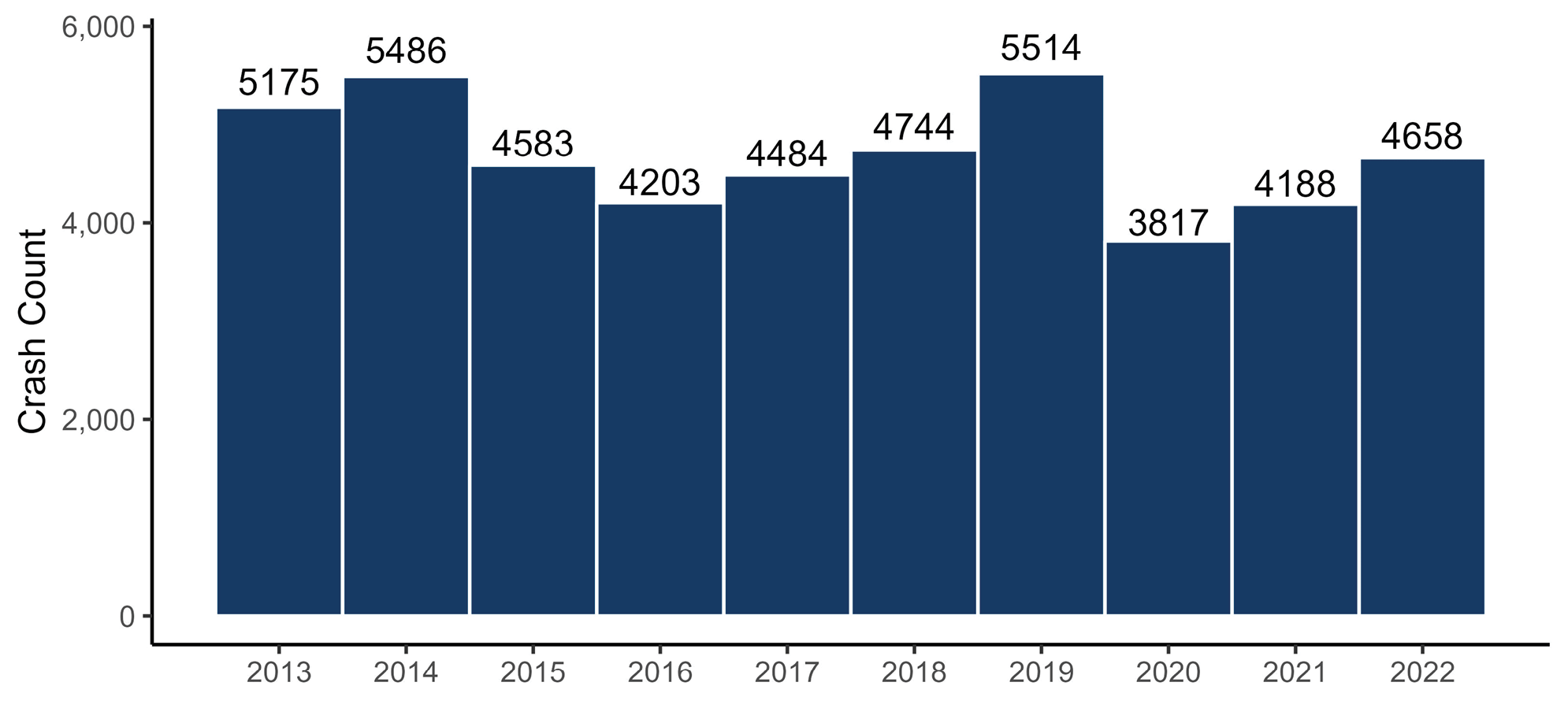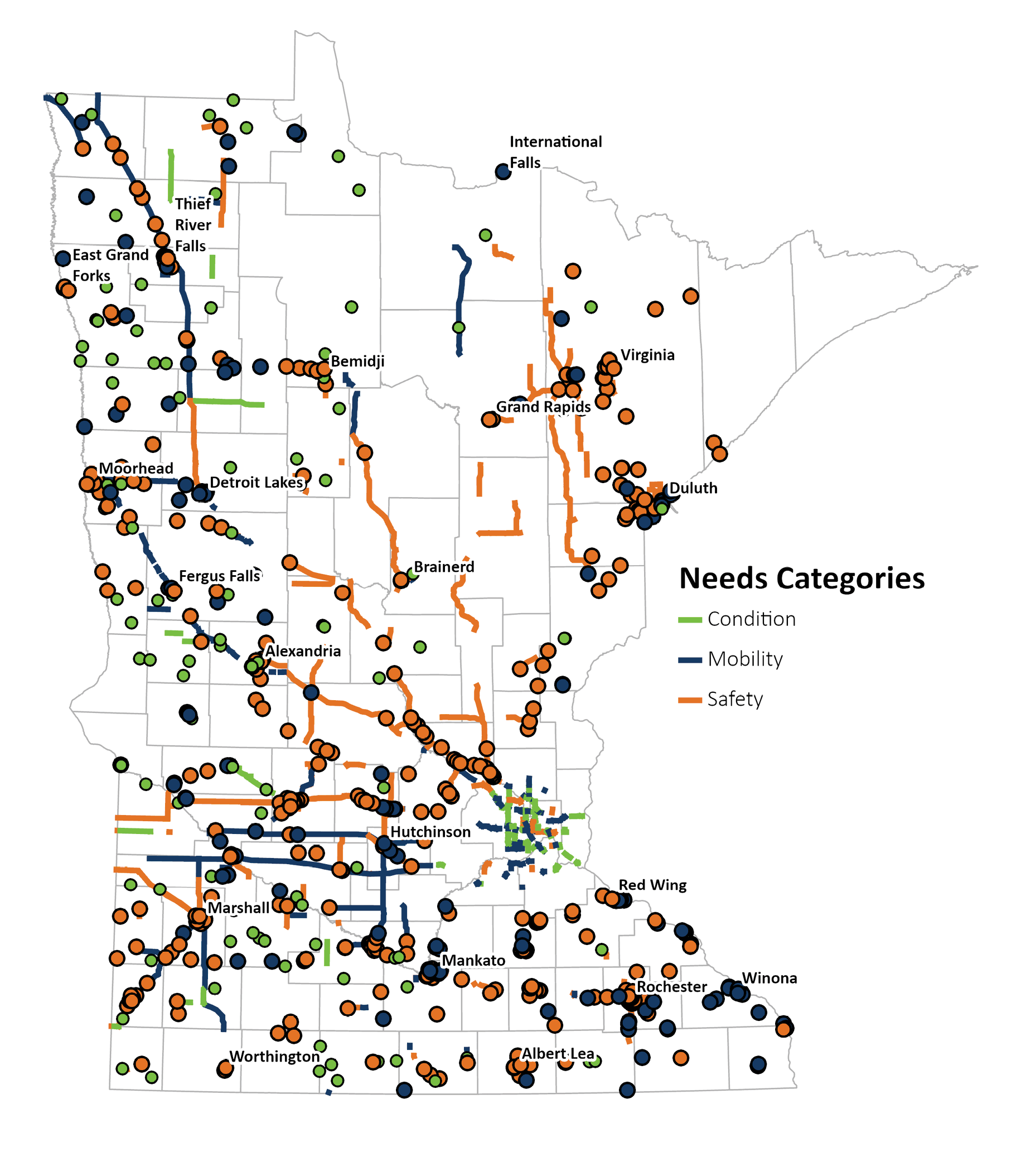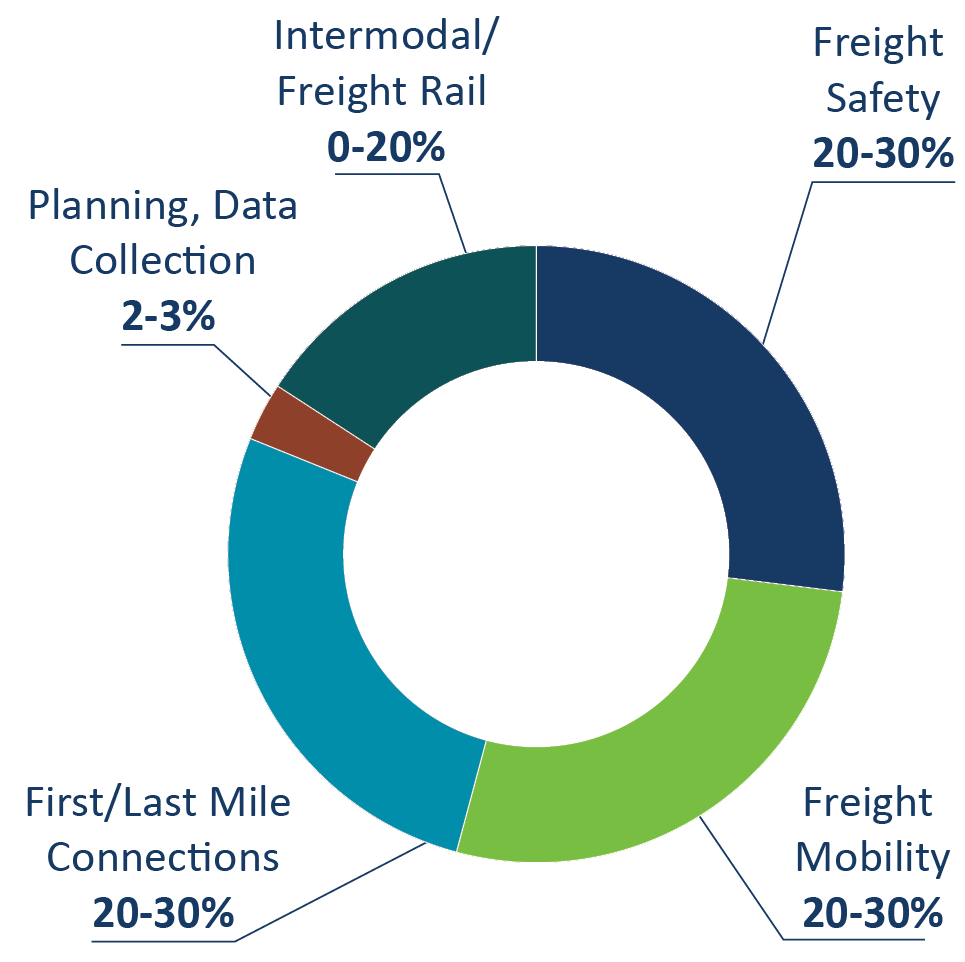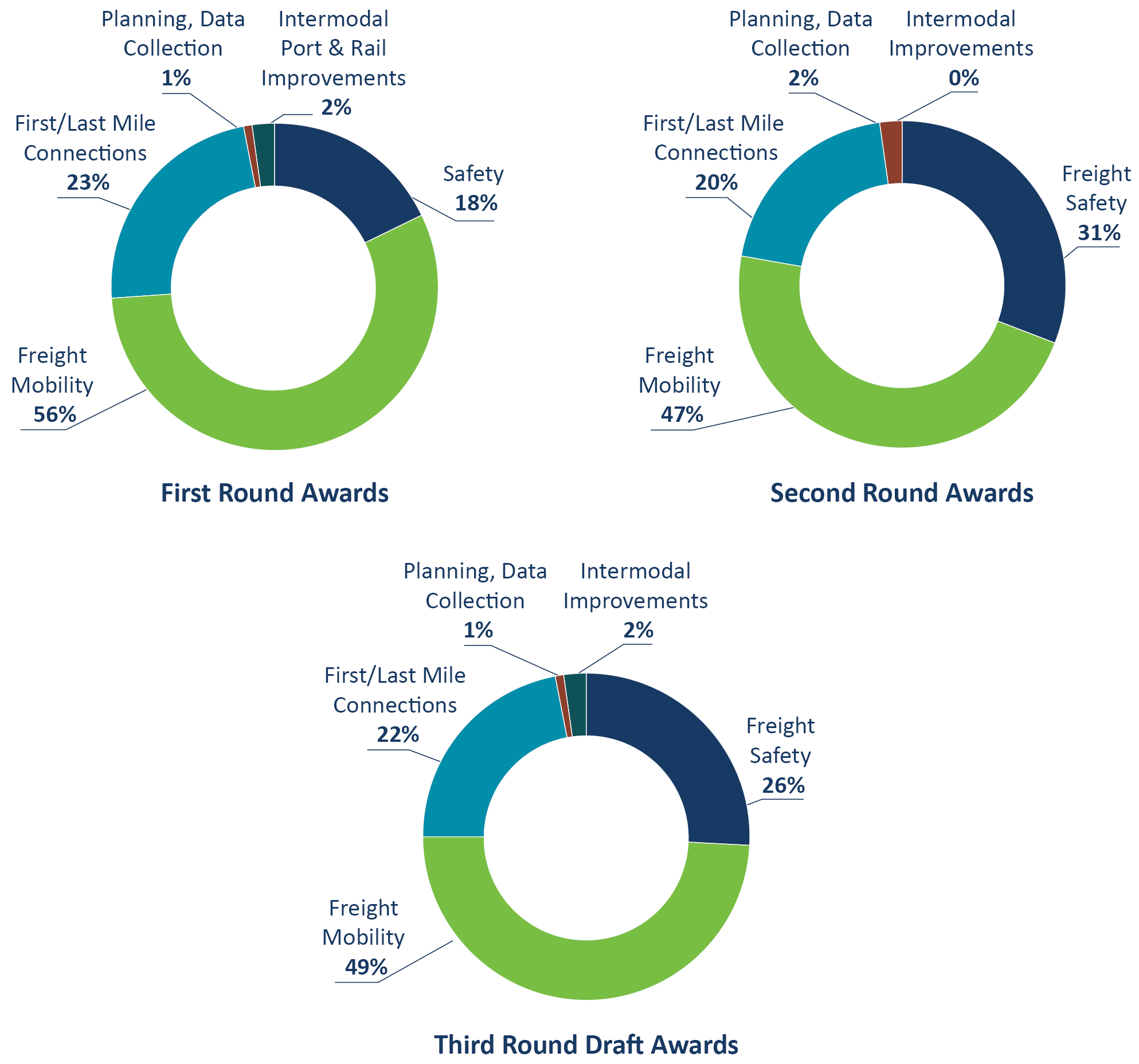- Download PDF of the report
- Executive Summary
- Introduction
- Chapter 1 – Importance of Freight to Minnesota
- Chapter 2 – Current and Future Freight Trends and Issues
- Chapter 3 – Minnesota’s Freight System Assets, Conditions and Performance
- Chapter 4 – Freight Forecasts
- Chapter 5 – Freight Policies and Strategies
- Chapter 6 – Sustainable Truck Trends and Strategies
- Chapter 7 – Freight Investment Plan and Implementation
- Appendix A – Critical Urban and Rural Freight Corridors
- Appendix B – Freight Performance Measures
- Appendix C – IIJA State Freight Plan Requirements
Freight Investment Plan and Implementation
Funding for freight projects originates from federal and state government sources and are both formulaic and discretionary. Each funding program, including the National Highway Freight Program (NHFP), has requirements for funding eligibility. Projects selected for investment for federal funding must meet specified criteria established in the IIJA.
There are several federal discretionary programs by which all states compete for limited funding. Minnesota must submit grant applications specified timeframes, which articulate the business case and substantiated need for each project. The process by which projects are identified, selected and prioritized for funding investment in Minnesota are discussed in this chapter.
Overview
The Freight Investment Plan identifies public freight investments in Minnesota funded through the National Highway Freight Program (NHFP) and other capital programs that will support MnDOT’s Minnesota GO Vision, the goals of the Statewide Multimodal Transportation Plan (SMTP), the goals of the Minnesota State Freight Plan and work towards implementing the Freight Action Agenda. The purpose of the Freight Investment Plan is to provide an overview of these investments; describe MnDOT’s approach to identifying projects to invest in; and coordinate federal, state and local investments on the freight network over the next ten years. This Freight Investment Plan builds on existing statewide policy and was developed to provide a consistent programmatic approach for the Minnesota Highway Freight Program (MHFP).
The MHFP was developed to allocate federal formula funds appropriated to the state through the NHFP. The NHFP was first created by the Fixing America’s Surface Transportation (FAST) Act and was continued in the Infrastructure Investment and Jobs Act (IIJA). In accordance with federal law (49 U.S.C. 70202), the Freight Investment Plan is required for the state to obligate funds from the NHFP to projects identified for funding by the state. The plan complies with federal law by listing projects funded with federal money for five state fiscal years under the FAST Act (state fiscal years 2016-2020) and eight state fiscal years under the IIJA (state fiscal years 2021-2028). Table 7-1 shows how much NHFP funding was, and is, available under the MHFP.
MnDOT is investing in freight improvements outside of the MHFP through the State Transportation Improvement Program (STIP) and the 10-year Capital Highway Investment Plan (CHIP). The Minnesota State highway Investment Plan has specifically targeted $600 million for freight over the next 20 years. Additionally, MnDOT and local partners often pursue state or federal grants through programs such as the Rebuilding American Infrastructure with Sustainability and Equity (RAISE) program, the Nationally Significant Multimodal Freight & Highway Projects (INFRA) program, and the Metropolitan Council’s Regional Solicitation.
Table 7-1: 2023-2024 National Highway Freight Program Funds in Millions each state fiscal year
| 2023 | 2024 | 2025 | 2026 | 2027 | 2028 | 2029 | 2030 |
|---|---|---|---|---|---|---|---|
| $14.6 | $22.2 | $22.2 | $21.6 | $21.6 | $21.6 | $22.6 | $22.6 |

Statewide Freight System Needs
Following the adoption of the 2018 Minnesota State Freight Plan, the Minnesota Department of Transportation (MnDOT) began the task of completing district-level freight plans for each of the eight MnDOT districts. The overall process for each of the district plans is summarized in Figure 7-1. Potential freight needs were identified through a review of safety, mobility and condition issues, as well as through the use of detailed stakeholder interviews and feedback. The needs were ranked to determine the most critical freight system investments prior to making final recommendations. These recommendations were reviewed with MnDOT OFCVO and District staff prior to making final plan recommendations and advancing the top scoring freight system investments.
Manufacturers’ Perspectives Studies
Each of the District Freight Plans relied on previous local and regional studies to identify issues and needs identified by freight stakeholders. The predominant source of these stakeholder-identified issues was the Manufacturers’ Perspectives Studies. These district-based studies were started in 2014 with the express goal of better understanding the needs and issues of local manufacturers and to forge strong, ongoing relationships between MnDOT and local business communities. District 8 was the first district to complete one of the studies. The project team conducted 125 one-on-one interviews with manufacturers in District 8 using a standard questionnaire and interview process. The results of these interviews were geospatially coded and included descriptions of various needs and issues identified by the businesses.
- Metro District / Urban Freight Perspectives Study (Phase 2) - 2020-2021
- District 3 / Central Minnesota (PDF) - 2019-2020
- District 7 / South Central Minnesota (PDF) - 2018-2019
- Metro District / Greater Twin Cities (Phase 1) (PDF) - 2018-2019
- District 6 / Southeast Minnesota (PDF) - 2018
- District 1 / Northeast Minnesota (PDF) - 2017
- District 2 / Northwest Minnesota(PDF) - 2016
- District 4 / West Central Minnesota (PDF) - 2015
- District 8 / Southwest Minnesota (PDF) - 2014
All of the District Freight Plans were scheduled such that the Manufacturers’ Perspectives Studies has been recently completed prior to the start of the plan development. This timing ensured that each plan could rely on a solid framework of stakeholder engagement and issue identification to compare and contrast to the data-driven assessments noted previously.
Figure 7-1: District Freight Planning Process

Freight Need Scoring Process
Freight needs in each district were identified using the three categories of safety, mobility and condition as well as through stakeholder outreach. A combined score was then calculated to account for any overlap between these issues. Finally, a truck volume score was applied to calculate the final adjusted score and apply a need rank. An example of the process from District 2 is shown in Table 7-3 below. The top ranked issue is based purely on a high safety score bolstered by an equally high truck volume score. Other highly ranked projects (D17, D3, S1) include scores for both safety and mobility. Note that while each district was allowed some degree of leeway in determining scoring thresholds and other factors that would influence the overall need scores and rankings, all districts largely following the overall scoring approach using scoring categories of safety, mobility, condition, truck volume and stakeholder identification.
Freight Safety
MnDOT’s approach to freight safety is guided by Minnesota Toward Zero Death (TZD), the state’s cornerstone traffic safety program. This program’s goals are to prioritize traffic safety and implement effective safety initiatives through evidence-based approaches and engagement with partners.
In 2022, the 4,797 truck-involved crashes accounted for 6.8% of Minnesota’s total of 70,266 crashes. The total number of truck crashes has varied from year to year but has averaged approximately 4,600 crashes per year (Figure 7-2) over the past decade. Due to their size and weight, truck-involved crashes are more likely to result in fatalities. In 2022, 1.4% of truck-involved crashes resulted in a fatality compared to 0.6% for all crashes.
Figure 7-2: Annual Minnesota Truck Crashes

MnDOT’s focus on rail safety is primarily focused on the interaction between trains and highway traffic at highway-rail grade crossings. The recent Minnesota Rail Crossing Safety Action Plan evaluated the 166 crashes at Minnesota’s more than 4,000 public grade crossings in the state and recommended various crossing improvement strategies. Air cargo and maritime cargo operations are typically regarded as the safest freight modes.
Table 7-2: Final Freight Need Cost Estimate Summary (5-year outlook)
| Need Type | Total Statewide Needs | Point Count or Segment Miles | Percent Assumed for Implementation | Unit Cost | Total Cost |
|---|---|---|---|---|---|
| Safety: Point | 393 | 393 | 8.4%1 | $705k (Lump Sum) | $23,273,460 |
| Safety: Segment | 254 | 1,399 | 7.9%1 | $439k (Per Mile) | $48,518,719 |
| Mobility: Point | 148 | 148 | 6.1%1 | $10.9M (Lump Sum) | $98,405,200 |
| Mobility: Segment | 302 | 1,422 | 5.0%2 | $562k (Per Mile) | $39,958,200 |
| Condition: Point | 109 | 109 | 5.0%2 | $6.4M (Lump Sum) | $34,880,000 |
| Condition: Segment | 61 | 274 | 5.0%2 | $0.7M (Per Mile) | $9,590,000 |
| TOTAL (5-Year) | 1,267 | - | - | - | $254,625,579 |
| TOTAL (20-year) | $1,018,502,316 |
1 - Based on proportions selected for concept development
2 - Based on minimum assumed proportion
Estimating Total Statewide Freight Needs
An estimate of the total value of freight needs in the state was developed using a combination of the freight needs identified during the District Freight Plans and average unit costs for construction of the improvement identified to address those needs. Table 7-2 provides a summary of the assumptions and the basic calculations used to develop the final estimate. After carrying through these calculations, the total estimated costs of implementing the needs are $255 million. It is assumed that these needs represent a snapshot in time that estimates the potential freight needs over a five-year outlook period. Therefore, to expand these costs to a 20-year forecast total, the estimated costs were multiplied by four to achieve a 20-year forecast freight needs estimate. Some of the key assumptions that are inherent in this estimate are:
- No consideration for inflation or other time discounts of money.
- The assumption that additional freight needs will develop over time based on normal wear and tear on the roadways and greater need to handle expanded freight traffic.
Due to these assumptions and limitations, the estimated $1.1 billion in statewide freight needs for the next 20 years represents a low estimate on the range of potential freight needs.
Table 7-3: Example Scoring Result, District 2 Freight Plan
| Issue | Truck Volume | Safety | Mobility | Condition | Total | Adjusted Total | ||||||
|---|---|---|---|---|---|---|---|---|---|---|---|---|
| ID | Score | Rank | Score | Rank | Score | Rank | Score | Rank | Score | Rank | Score | Rank |
| D12 | 100% | 1 | 100% | 1 | NA | NA | NA | NA | 100% | 1 | 100% | 1 |
| D14 | 90% | 2 | 100% | 2 | NA | NA | NA | NA | 93% | 2 | 93% | 2 |
| D17 | 80% | 3 | 100% | 7 | 40% | 59 | NA | NA | 75% | 3 | 75% | 3 |
| D3 | 60% | 9 | 100% | 6 | 60% | 44 | NA | NA | 70% | 4 | 70% | 4 |
| S1 | 50% | 14 | 20% | 51 | 80% | 22 | NA | NA | 50% | 21 | 67% | 5 |
Figure 7-3: Identified Statewide Freight Needs

Minnesota Highway Freight Program Development
The FAST Act and the NHFP provide flexibility to the states in determining how each state will spend NHFP funding. MnDOT developed a centralized competitive solicitation, the MHFP, to solicit projects from a wide variety of state and local partners.
The MHFP was developed at the recommendation of local stakeholders on the Statewide Freight Investment Committee and through input received from other groups, such as the Minnesota Freight Advisory Committee, Minnesota-based Metropolitan Planning Organizations (MPOs) and Regional Development Organizations (RDOs). MnDOT, with input from these stakeholders, designed the application evaluation process to prioritize investments that align with the Minnesota GO Vision, the SMTP, the goals and objectives of the State Freight Plan and its Freight Action Agenda.
Applications are evaluated according to scoring criteria. MnDOT and freight stakeholders worked to develop criteria that support the Minnesota GO Vision, the objectives of the SMTP, the goals and objectives of the Minnesota State Freight Plan and work towards implementing the Freight Action Agenda. Mobility is a key theme across these plans— moving goods and services to people effectively and efficiently is key to the success of the state across economic, social and environmental dimensions.
MHFP criteria score projects based on mobility through performance measures such as Heavy Commercial Average Annual Daily Traffic (HCAADT) counts, Truck Travel Time Reliability and if the project removes a barrier or upgrades a roadway to 10-ton standards. Safety is also a necessary theme to the success of the state freight and state transportation systems. MHFP criteria score project safety by looking at crash rate reductions, addressing sustained crash locations and addressing safety issues identified in safety plans. Unique to the MHFP, MnDOT also evaluates proposed projects on environmental justice impacts. Within the most recent round of the MHFP solicitation, MnDOT added a new Sustainability and Emissions scoring criterion and increased available points for the Environmental Justice criterion. An increased importance on these criteria contributes to the State Freight Plan’s goal of protecting the environment and communities and aligns with the Minnesota GO Vision and SMTP. MnDOT’s Office of Freight and Commercial Vehicle Operations (OFCVO), which facilitates the solicitation, coordinated with MnDOT’s Office of Sustainability and Public Health (OSPH) and MnDOT leadership to develop questions for those criteria and how answers should be scored.
Since 2017 there have been three formal MHFP solicitation rounds. This Freight Investment Plan discusses development of the third MHFP solicitation (state fiscal years 2026-2028) and its resulting investments.
MnDOT developed a centralized competitive solicitation, the MHFP, to solicit projects from a wide variety of state and local partners.
Environmental Justice Integration in the Minnesota Highway Freight Program
MnDOT integrated environmental justice in the Minnesota Highway Freight Program in 2021. In addition, MnDOT also added a separate scoring criterion for equity in 2023. These changes are unique in that many states do not evaluate on a quantitative basis these scoring criteria in the project scoring, ranking and selection process for their freight projects.
In the most recent round of the MHFP solicitation, several specific questions were added on the MHFP application that ask project applicants to describe how their project has considered and incorporated both environmental justice and equity in project development. These questions were developed and scored in collaboration with MnDOT Office of Equity and Diversity staff. Project applicants were asked to:
A separate sub-committee of MnDOT reviewers with experience and training in environmental justice and equity was created with staff from the Office of Equity and Diversity and the Office of Freight and Commercial Vehicle Operations to score and rank projects for this scoring criteria. The resulting score from the environmental justice and equity criterion contributed to the overall project score. Inclusion of this criterion in the MHFP ensures that the freight projects MnDOT invests in prioritize environmental justice and equity, aligning with the Minnesota GO Vision and SMTP.
Statewide Freight Investment Committee
The MHFP was designed via recommendations from the Statewide Freight Investment Committee. The Statewide Freight Investment Committee acts as a review and oversight body; represents a wide array of interests; discusses freight investment strategies, policies and program operation; and recommends decisions to MnDOT leadership for approval. These investment recommendations include investments funded through the MHFP. The Committee’s membership includes MnDOT planning, programming, policy, state aid and functional area staff, as well as representatives from Metropolitan Planning Organizations (MPOs), Regional Development Organizations (RDOs), counties, cities, the Federal Highway Administration (FHWA) and the Chair of the Minnesota Freight Advisory Committee (MFAC). The variety of organizations represented by the Committee is reflective of the breadth of goals and objectives of the State Freight Plan.
For the third round of the MHFP, MnDOT met with the Freight Investment Committee six times, as well as internal MnDOT committees, to develop this round’s solicitation and recommend selected draft awards.
Approach Prior to the Third Round Of MHFP
The FAST Act was signed into law in December 2015, making the NHFP funding immediately available to Minnesota for state fiscal years 2016 through 2020. Since December 2015 was already halfway through state fiscal year 2016, MnDOT chose to initially allocate some of the funding quickly, applying it to known high priority freight-specific projects. During this time OFCVO convened groups of stakeholders including re-creating the Freight Investment Committee to provide input into how the NHFP funds should be invested as shown in Table 7-4. Based on local stakeholder input a desire to provide flexible funds across the state and provide opportunities for investment on local networks was the desired outcome. From this sequential approach the Minnesota Highway Freight Program was created.
In 2017, MnDOT then held the first round of MHFP solicitation for projects in state fiscal years 2019- 2022. In 2020, MnDOT held the second round of MHFP solicitation for projects in state fiscal years 2022-2025.
Table 7-4: Membership of the Statewide Freight Investment Committee
| Name | Organization | Representing |
|---|---|---|
| Aaron Tag | MnDOT Metro District | Twin Cities MnDOT District |
| Ashley Jacobson | MnDOT Bridge Office | Bridge Program Planning |
| Andy Hubley | Arrowhead Regional Development Commission | RDOs |
| Brad Utecht | MnDOT Office of Transportation System Management (OTSM) | Statewide Investment Planning |
| Brian Gage | MnDOT OTSM | Statewide Capital Programming |
| Brian Sorenson | MnDOT Office of Traffic Engineering (OTE), Safety and Technology (OTST) | Traffic Engineering |
| Brianne Nelsen | Upper Minnesota Valley Regional Development Commission | RDOs |
| Bryan Anderson | MnDOT District 1 | Greater MN MnDOT District Planners |
| David Burns | Metropolitan Council | Twin Cities MPO |
| Deb Deluca | Duluth Port Authority | Chair of the MFAC |
| Derek Leuer | MnDOT OTSTOTE | Traffic Engineering |
| Jason Craig | MFAC | Vice Chair of the MFAC |
| Jennifer Wiltgen | MnDOT Metro District Office of Advancing Equity | Twin Cities MnDOT District |
| Jon Huseby | MnDOT District 8 Engineer | Greater MN MnDOT Districts |
| Jon Solberg | MnDOT Sustainability, Planning and Program Management (SPPM) Division | Division and Agency Leadership |
| Kenneth Johnson | MnDOT OTSTOTE | Traffic Engineering |
| Lisa Freese | Scott County | Twin Cities Counties |
| Mike Wenholz | Arrowhead Regional Development Commission | RDOs |
| Nick Klisch | Cottonwood County | Greater Minnesota Counties |
| Nicki Bartelt | MnDOT Bridge Office | Bridge Program Planning |
| Paige Melius | ARDC | RDOs |
| Patrick Wiedemann | MnDOT OTSM | Statewide Capital Programming |
| Peter Dahlberg | MnDOT OFCVO | MnDOT Freight Office |
| Philip Schaffner | MnDOT OTSM | MnDOT OTSM Leadership |
| Ron Chicka | Duluth-Superior Metro Interstate Council | Greater Minnesota MPO |
| Scott Mareck | Federal Highway Administration (FHWA) | Technical Services Team Leader, FHWA Minnesota Division |
| Shaker Rabban | MnDOT OTSM | Statewide Asset Management Planning |
| Shelly Meyer | MnDOT OFCVO | Freight Office Leadership |
| Shiloh Wahl | MnDOT District 4 Engineer | Greater MN MnDOT Districts |
| Siri Simons | MnDOT Office of Sustainability and Public Health (OSPH) | Sustainability and Emissions |
| Steve Bot | City of St. Michael | Minnesota Cities and City Engineers |
| Steve Elmer | Metropolitan Council | Twin Cities MPO |
| Steve Peterson | Metropolitan Council | Twin Cities MPO |
| Susan Wimberly | FHWA | Deputy Division Administrator, FHWA Minnesota Division |
| Tad Erickson | Region Five Development Commission | RDOs |
| Ted Schoenecker | MnDOT State Aid | State Aid Leadership |
| Tim Sexton | MnDOT SSPM Division | Division and Agency Leadership |
| Torey Hunkus | MnDOT OFCVO | MnDOT Freight Office |
Third Round of the MHFP Solicitation
In 2023, MnDOT held the third round of MHFP solicitation for projects in state fiscal years 2026- 2028. Awards were announced in early 2024. About $63 million was available in this solicitation. MnDOT planned approximately $21.6 million per state fiscal year, plus $5 million per year from matching state funds. The minimum project cost threshold was $500,000 and the maximum award to a project was one half the total amount available in any one fiscal year.
MnDOT made some changes for the third round MHFP due to NHFP changes that resulted from IIJA being signed into law. States can now use up to 30% of NHFP funding on freight intermodal or freight rail projects (subject to certain restrictions). Additionally eligible for NHFP funding are projects for the modernization/rehabilitation of a lock and dam or a marine highway corridor, connector or crossing that are functionally connected to the National Highway Freight Network (NHFN) and likely to reduce on- road mobile source emissions.
Such eligible projects would fall under the intermodal category of the MHFP application. Lastly, IIJA allowed more miles to be designated as Critical Rural Freight Corridors (CRFCs) and Critical Urban Freight Corridors (CUFCs) (see Critical Urban and Rural Freight Corridors section).
Eligibility of Applicants
MHFP is open to applicants from MnDOT districts, cities, counties, Tribal governments, railroads, airports, ports and other federal aid eligible entities or partnerships. Applicants select a specific investment category for their project to compete in one of the following major categories:
- Freight Safety
- Freight Mobility
- First/Last Mile Connections
- Intermodal Connections
- Planning

These categories were identified through feedback from the Statewide Freight Investment Committee, the Minnesota Freight Advisory Committee and internal MnDOT committees.
Eligible projects include new construction and add-ons or up-scopes to existing projects, given the applying project provides a clear freight benefit. Specific to MnDOT’s implementation preliminary engineering and right of way costs (project planning, engineering design and related work preparatory to the advancement of a project to physical construction) are not eligible. Based on stakeholder’s recommendations, certain types of projects are also not eligible, (even though the law allowed for them) including acquisition of equipment, highway ramp metering and diesel retrofitting. The MHFP may provide funding up to 80% of the eligible project cost. Projects on the Interstate may receive up to 90% of the eligible project cost. . The Minnesota Highway Freight Program website has the most recent MHFP application, which includes more details on project eligibility for the third round of MHFP solicitation.
MnDOT has programmed some funding specifically for freight planning and freight data collection to ensure future updates of the State Freight Plan and other related efforts comply with federal requirements. These projects are included below in Table 7-5.
Table 7-5: MnDOT Freight Planning and Freight Data Collection Projects Funded Through MHFP
| State Fiscal Year | Project | Amount | Project Category |
|---|---|---|---|
| 2026 | Statewide Trucking Parking Study Update | $300,000 | Planning |
| 2026 | Statewide Truck Parking Information Management Systems Replacement Project | $550,000 | Safety |
| 2027 | State Freight Plan Update | $600,000 | Planning |
Investment Approach
For each round of the MHFP solicitation, MnDOT, with input from the Statewide Freight Investment Committee, adopts an investment direction with targets for the distribution of funding across project categories and geographic areas. The project categories are freight mobility, freight safety, first/ last mile connections, intermodal/freight rail and planning and data collection. These category targets ensure that freight investments funded through MHFP will contribute to the State Freight Plan goals that address freight needs in Minnesota. Projects in the intermodal and freight rail category were awarded first and the remaining funding was awarded to the remaining projects based on the categorical and geographical investment targets.
Figure 7-4: Proposed Project Category Investment Targets for the Third Round of MHFP

Investment targets for projects located in the Twin Cities Metropolitan Area or Greater Minnesota (Minnesota outside of the Twin Cities) were adopted to ensure geographic balance of funding and projects. This split is based on DEED data comparing the percentage of people employed and gross domestic product of the Twin Cities Metro region with Greater Minnesota.
The targets are soft targets and are not mandated. If enough projects are not submitted in one region the remaining funds will be used entirely in any one program year. These geographic targets will ensure freight investments funded through MHFP provide benefits throughout the state of Minnesota.
Table 7-6: Proposed Geographic Targets for the Third Round of MHFP
| Geographic Area | Funding Target | Percentage Target |
|---|---|---|
| Metro District | $48,900,000 | 60% |
| Greater Minnesota | $32,600,000 | 40% |
Targets include state match targets provided by OTSM for MnDOT District projects
Project Selection and Awards
During the third round of the MHFP, MnDOT received 25 total project applications. Applications included one intermodal project, ten mobility projects, eight first/last mile connection projects and six safety projects. In total, applicants requested $158.1 million in funding. Split geographically, nine of the projects were located in the Twin Cities Metropolitan area, requesting $97.4 million in total and 16 of the projects were located in Greater Minnesota requesting $60.7 million in total. MHFP received applications covering a variety of project types:
- 7 Freight Road Mobility projects
- 6 Road Reconstruction/Realignments
- 3 Interchanges
- 2 Roundabouts
- 2 Truck Parking Improvement Projects
- 1 Highway Railway Grade Separation
- 1 Snow fence project
- 1 Intermodal Access Road
- 1 Bridge
- 1 Shoulder Widening
Based on the adopted investment direction, OFCVO first selected the intermodal project as a draft award. OFCVO then ranked the remaining projects based on score and assigned them to them into Twin Cities and Greater Minnesota projects. OFCVO then selected the top projects in each geographic category, selecting the appropriate number of projects in each geographic category to best meet the geographic balance funding targets.
In December 2023, MnDOT presented the draft MHFP awards to the Statewide Freight Investment Committee and requested and received its approval of the draft awards. The deliberation process with the Committee involved ensuring project selections were balanced across categories and geographically. The freight mobility category received the most applications and makes up the largest amount of draft funding awarded. The freight mobility category includes a wide range of project types and so MnDOT and the Statewide Freight Investment Committee were comfortable with expanding that category beyond the target. Additionally, only receiving one intermodal project increased the funding share available to other categories. Figure 7-5 compares the category investment targets to the draft award distribution and Table 7-7 compares the geographical investment targets to the draft award distribution.
In February 2024, following the Committee’s approval, OFCVO shared the draft awards with MnDOT’s Transportation Program Investment Committee, who approved them. OFCVO then requested and received approval from the Commissioner of MnDOT. Table 7-8 shows the list of draft awarded projects.
Figure 7-5: Comparison of Third Round Project Category Investment Targets and Draft Awards

Table 7-7: Comparison of Geographic Investment Targets and Results
| Geographic Area | Funding Target | Funding Target Percentage | Funding Awarded | Funding Awarded Percentage |
|---|---|---|---|---|
| Metro District | $48,900,000 | 60% | $38,125,000 | 47% |
| Greater Minnesota | $32,600,000 | 40% | $43,375,000 | 53% |
Targets include state match targets provided by OTSM for MnDOT District project
Table 7-8: Awarded Projects for the Third Round of MHFP
| State Fiscal Year | Project | Amount | Project Category |
|---|---|---|---|
| 2026 | Statewide Trucking Parking Study Update | $300,000 | Planning |
| 2026 | Statewide Truck Parking Information Management Systems Replacement Project | $550,000 | Safety |
| 2026 | MnDOT Rest Area Program – I-94 Enfield Rest Area Truck Parking Expansion | $2,700,000 | Safety |
| 2026 | MnDOT District 4 – Snow Fence on I-94 near Rothsay | $2,250,000 | Mobility |
| 2026 | MnDOT Rest Area Program - I-94 Big Spunk Lake Truck Parking Expansion | $3,400,000 | Safety |
| 2026 | City of Cottage Grove - 100 St SW Arterial Roadway Project | $5,000,000 | First/Last Mile |
| 2026 | Sherburne County - US169 and CR4 Rural Safety and Mobility Project | $10,800,000 | Mobility |
| 2026 | MnDOT District 8 - US212 and TH15 Roundabout | $4,400,000 | Safety |
| 2027 | State Freight Plan Update | $600,000 | Planning |
| 2027 | Carver County - MN5 Arboretum Area Safety Project | $10,800,000 | Safety |
| 2027 | Scott County - MN13 River, Rails and Highway Freight Improvement Project | $10,800,000 | Mobility |
| 2027 | City of Coon Rapids - US610 East River Road Interchange | $10,800,000 | First/Last Mile |
| 2027 | Bridgewater Township - Comus Industrial Park Intermodal Facility Access Road | $1,600,000 | Intermodal |
| 2028 | MnDOT District 7 - US169 Mankato Area Revitalization Project | $10,800,000 | Mobility |
| 2028 | City of Clearwater - I-94 and MN24 Improvements | $5,000,000 | Mobility |
| 2028 | City of Mankato - Veterans Memorial Bridge Rehabilitation | $6,100,000 | First/Last Mile |
| Total: | $81,500,000 |
Note: Projects shown were updated July 2025 in alignment with the Statewide Transportation Improvement Program.
Summary of MHFP Investments
Figure 7-6 below compares the distribution of investments across the different project categories over the three rounds of the MHFP. Project categories have received roughly similar proportions of MHFP funds each round, with the freight mobility category receiving the largest proportion of investment. The freight mobility category can include a range of project types, which contribute to decreasing congestion and increasing efficiency.
Increasing freight mobility is a goal of the State Freight Plan and decreasing congestion and increasing efficiency also contribute to attaining various other State Freight Plan goals such as improving freight safety, supporting the economy and protecting Minnesota’s environment and communities.
Figure 7-6: Historical Project Category Investment Summary

Overall, MnDOT strives to be geographically balanced in its distribution of NHFP funds through the MHFP. This ensures that freight investments funded through MHFP provide benefit throughout the state of Minnesota.Table 7-9 below demonstrates the summation of all uses of NHFP funding balances close to proposed geographic balance targets of 60% for the Twin Cities Metro and 40% for Greater Minnesota.
Table 7-9: Historical Geographic Balance Investment Summary
| Funding Round | Fiscal Years | Twin Cities Metro | Greater Minnesota | Total |
|---|---|---|---|---|
| Pre-MHFP | 2016-2018 | $25,300,000 | $25,000,000 | $50,300,000 |
| Round 1 | 2019-2022 | $82,000,000 | $18,000,000 | $100,000,000 |
| Round 2 | 2023-2025 | $44,325,900 | $23,864,100 | $68,190,000 |
| Geographic Distribution of Funding Prior to Round 3 | 2016-2025 | 69% | 31% | 100% |
| Round 3 | 2026-2028 | $38,125,000 | $43,375,000 | $81,500,000 |
| Total Geographic Distribution of Funding | 2016-2026 | 63% | 37% | 100% |
| Total | - | $189,750,900 | $110,239,100 | $299,990,000 |
Critical Urban and Rural Freight Corridors
The FAST Act required the FHWA to establish a National Highway Freight Network (NHFN). As part of this, NHFP funding must go to projects located on the NHFN. NHFN includes four subsystems, two of which are the Critical Urban Freight Corridors (CUFC) and Critical Rural Freight Corridors (CRFC). CUFCs and CRFCs are designated by states and MPOs (which meet population requirements). Each state is allotted a certain number of CUFCs and CRFC miles based on federal law.
MnDOT used a project-first approach to designate CUFCs and CRFCs from the third round of the MHFP (and has done so for prior rounds). This means that MnDOT designated the stretch of road projects are located on as either a CUFC or CRFC after it awarded projects. MnDOT then used remaining CUFC and CRFC mileage to connect projects from the third round that were located off of the existing NHFN in the state to the NHFN. MnDOT did not use a hierarchal approach to corridor designations. Corridors designated may be undesignated as projects are completed and mileage is needed to continue allocating NHFP funds on a flexible basis for future projects. MnDOT continues to connect these corridors in alignment with the National Multimodal Freight Network and the National Strategic Freight Plan. MnDOT discussed and received support from the Statewide Freight Investment Committee on this approach. These corridors are listed in Appendix A: Critical Urban and Rural Freight Corridors.
Investment Plan and Program Implementation
Moving forward into implementation, MnDOT will work with local partners to develop projects selected as part of the Minnesota Highway Freight Program and Intermodal Program.
MnDOT intends to continue the Minnesota Highway Freight Program competitive solicitation for additional freight investments in the future. This will appear as a two-year cycle on a revolving basis based on the availability of ongoing federal formula freight funds appropriated by Congress to the NHFP. Through regional District Freight Plans completed in each region of the state, freight needs will continue to be explored with local and regional stakeholders to help support a pipeline of high priority projects to future MHFP solicitations. OFCVO will continue to look for ways to better integrate freight into future construction projects, create further connections between freight related efforts and coordinate across different offices in MnDOT.
Future efforts will be focused on the incorporation of these improvements into statewide programming processes as well as linking to and carrying out the Freight Action Agenda, the goals and objectives of the State Freight Plan, the objectives of the SMTP and the Minnesota GO Vision. As noted in the prior chapter MnDOT has connected the State Freight Plan with the Minnesota Statewide Highway Investment Plan for the first time by identifying the universe of unmet freight needs. With this new resource, MnDOT has a clearer picture of how freight investments can be prioritized among all investment needs and asset categories.
MnDOT is supporting new practices that help align investments in areas of ongoing research such as freight in complete streets, freight and goods movement in urban areas, freight sustainability and zero emission investments, freight impacts to sensitive communities and environmental justice benefits of federal investments. MnDOT freight planning staff will continue to meet with the Statewide Freight Investment Committee, the Minnesota Freight Advisory Committee, other government partners and freight industry stakeholders to address future freight needs, issues, investments, policies or concerns.
